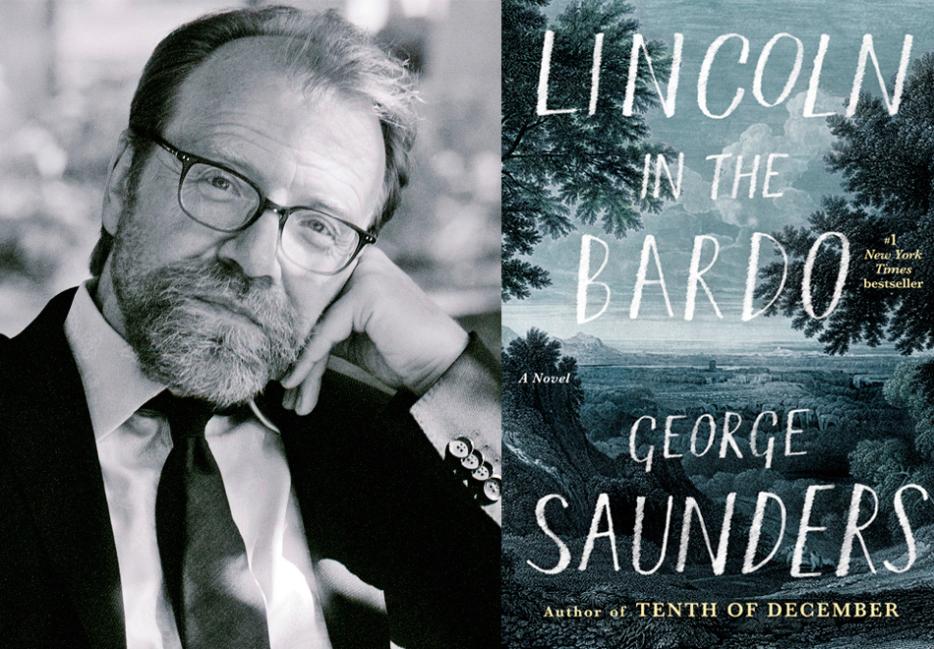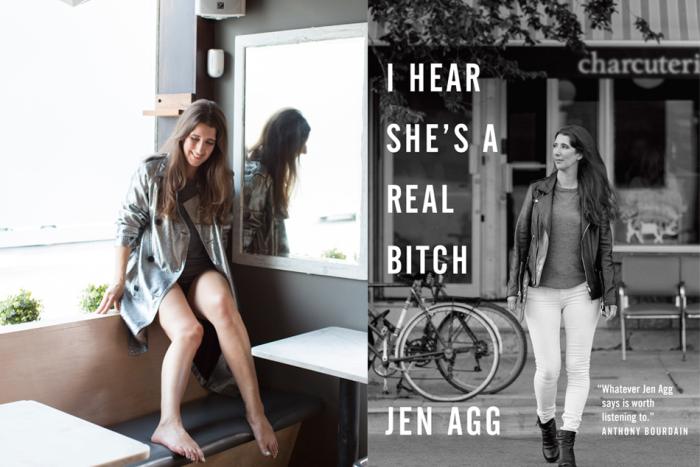The Hamlet of Whitby, Ontario, was once a destination of note, marginally famous for its painstaking miniature village. I went there as a child, discovering in it a paradise that I hoped to encounter elsewhere, but never did. Beyond the simple fact of its existence, the village’s most striking feature was a house that bore a flaming [[FN: Smoldering]] hole in its roof. In the street below, firefighters aimed hoses in its vague direction, mouths locked in silent, frenzied os. Steps away, other homes sat comfortably unengulfed, model children playing with model dogs. Absolutely a wedding or a barbecue was happening within arm’s reach.
I think of this one morning as George Saunders, on the phone from his California home, discusses his love of contained worlds—spaces (physical and otherwise) that allow him to perceive all the borders, and thus describe them with as much latitude as his imagination allows. In 2009, Saunders performed “AN IN SITU STUDY” in a Fresno tent city, hoping to “explore this unusual community of homeless people and learn something of its inhabitants.” Softly anthropological as it may sound, Saunders approaches these settings, in both fiction and not, with the full power of his compassion in play. The comedy of tone, vocabulary, and characterization tempers what might otherwise feel too painful, drawing his subjects close.
Familiarity, in Saunders’s case, does not breed contempt. Rather, it feeds equanimity, allowing him to write about pre-election Trump rallies with a rare and uncompromising view of each faction’s psychic enclosure. “You could get to know every single shed and every tent and every inhabitant,” he says of his time in Fresno. It’s not entirely dissimilar from standing within a crowd of bellowing Trump supporters, cataloguing the variety of hats that dot the horizon.
Saunders’s first novel Lincoln in the Bardo (Random House) nudges his gift for negative capability in an even more ambitious direction than his previous work. Like his 2013 Story Prize-winning collection Tenth of December, or 1996’s CivilWarLand in Bad Decline, Lincoln mines liminal spaces to tell stories of grief, kindness, and repetition—in this instance, locating it in the Bardo, a Tibetan vision of intermediate afterlife. Structured by way of descriptive quotations, Saunders calls on voices of both the living and dead in order to frame one night in Abraham Lincoln’s life. Based on various reports that Lincoln visited his newly deceased son Willie’s grave to hold him, alone in his burial chamber, Saunders animates a series of ambient “sick” characters who populate the Bardo in different forms, interred behind a fence that keeps them from the materially alive.
Waiting for his coffee to kick in, Saunders spoke with me about fences and other obstructions, and how depicting something like a house fire in tandem with a celebration is easier to write—and comprehend—when rendered in miniature.
*
Naomi Skwarna: Congratulations on the release of your “debut novel.”
George Saunders: Thank you. Now I can go back to work without too much shame.
How wonderful that there hasn’t been a significant shame backlash.
Yeah, you’ve got to set your bar high. “Thanks for publishing my book—my self-loathing didn’t get any worse.”
Was there a sense of freshness in touring with your first novel, rather than a collection of stories, as you did in 2013 with Tenth of December?
Well, it finally occurred to me that all these people [on the book tour] are rooting for you, as the author. They want you to try harder things, and they’re with you when you do. I’d get into certain places with this Lincoln book where it seemed like I had to go out on some new—and thin—ice. And then on tour, at signings, you’re like, “these are my people.” And in finding out more about them, I’m actually making myself a better writer, because I can find more nuance in the future.
Is there an example of an encounter on this tour that has made you a better writer?
People are very generous and articulate about how they were moved by it, and where. They’ll come up and tell me about loved ones they’ve lost. So you just take that bit of affirmation and you add it to your bag: okay, so as far out as I may have gone on this book (in the direction of assuming that other people are like me), I can go even further.
Can you cite a way in 1which you went further with Lincoln in the Bardo?
It felt like I was getting a little more emotionally frank; trying to be more comfortable in areas that previously I might’ve considered too straight or too earnest. Maybe it was just as simple as: you write something, you get a positive response from it. One thing I noticed is that, habitually, I’m a little more sensitive to the negative response. It just wilts me to be criticized. So that’s something to think about in terms of psychological dynamics. Are you correctly registering the positive reactions? Not for ego reasons, but for reasons of future writing; that whatever you’re doing here, whatever chances you took, were paying off.
I think it reflects on something in the book—the varying descriptions of the moon, by the different writers attending the Presidential gala that’s described at the beginning. Any form of consensus on what the moon looked like that night would’ve rung false. Everyone experiences these things so differently, but they’re no less true.
You find out what your book is by the nature of the disagreements about it. I like that idea, that truth is actually a bunch of contradictions at once, and the particular flavour of the truth has to do with flavour of those contradictions—both in terms of your work, but also of life in general.
Have you been seeing that in the readers you speak to about it—different flavours of agreement?
There’s a fraction of people who really aren’t liking it, who seem really put off by the epigrammatic quality. I’ve gotten letters that say, “I just don’t know how to read this book.”
Yeah, I felt like I had to train myself to read it. It’s choral. Eventually I just got used to it, like reading A Clockwork Orange, where after however many pages of slowness, you learn the dialect.
Exactly. The idea from the writer’s point of view is that you don’t do that just to be clever. You do it because once the person learns the dialect, they can get into higher registers.
How did you decide to write the novel as a series of quotations, which sometimes feels like a script?
Many years ago I started another book set in a graveyard that was inspired by, or sort of co-inspired by the advent of the chatline. I just loved the way chatlines looked on the page. You have the attribution and then some incoherent text that was then interrupted by someone else’s incoherent text that didn’t address the first—that cross-talking. So I tried to write a book with a bunch of spirits in a graveyard, cross-talking. But that book kind of died of its own weight, because there was nothing going on. So that was in my mind, and then, at some point, for quite a long time, I was trying to write this Lincoln material as a play.
When did the play become a novel?
It was just one of these writerly moments when I started putting the history in, thinking maybe I could put it into some sort of third-person way, and that just felt boring. So I hit on the idea of sampling the historical bits, just using them verbatim. So the ghosts still had the attribution at the beginning of the text, and the historical ones had it at the bottom. And something about that just bugged me, the way it looked on the page; the way it underscored the difference between the living and the dead. And so just on a whim, I moved the ghost attributions to the bottom, like they are now.
It’s interesting to know that you unified the living and the dead through attribution.
It speaks a little bit to the way that art, at least for me, is very iterative. The way you get to the interesting solution is by coming to the problem over and over again, making little adjustments each time. And then you look up and you’re like, “Oh, of course. That’s how I want to do it.” It wasn’t a big a-ha moment, it was a series of hmm, maybe moments. It’s a little bit less dramatic than the terms by which we usually discuss art. If you come at a problem many thousands of times, at the end, you’ll have a solution no one could’ve imagined at the beginning.
It’s nice to push back against the idea that every artistic move is vast and observable, rather than tiny millimeters of change.
The writer doesn’t know at the beginning! A story that comes to mind is, somebody asked somebody, maybe Fitzgerald or Hemingway, “How did you go broke?” and their answer was, “Gradually and then all at once.” For me, it was fifteen years of gradually moving toward this form.
As you were working on it, were you in any way reacting to things that were happening in the world?
Not really, because, well, it was pre-Trump for sure. Those rosy Obama years gave me permission to turn my eye away from contemporary politics. In some ways, you’re always reacting to contemporary politics. But I was really more in that dreamland of this imaginary 1862 for all that time.
At a certain point, I felt like I was reading with a parallel awareness of politics that have became more present on a daily basis. For instance, the Black Lives Matter movement—
Well, sure, that’s true. Yep. Yes. But also, the other thing is that in America, those politics have been active since I was a little kid.
Yes.
It comes to the surface every now and then, and then it gets quiet. Even the brutality is enacted in the same old ways, and it’s defended with the same old linguistic tropes. I think things have probably gotten somewhat better, but the basic dynamic is still tragic.
I see that in the fight between Farwell and Stone near the conclusion of the book. Other people have alluded to this too, the Civil War-era family of ghosts in CivilWarLand in Bad Decline, doomed to pantomime their own murder-deaths at the hands of the patriarch. Performances of often violent repetition.
I think we do it too! I get up every day and my mind starts ticking in the same old patterns. On my fortieth birthday, I had this experience of walking to class to teach, thinking, “You’re going to be fine, it’s going to be good." And I don’t remember what it was exactly, but it was some kind of little projective thing about how nice it would be when summer came and I could get back to work. And I thought, oh my god, I’ve been having this thought for … maybe my whole life. When I was in school I used to have it! And I thought, isn’t it interesting that we feel we’re made fresh every moment, but actually in some way of seeing it, we’re like these little robots who have the same thought patterns and apply them to different physical realities?
[Quietly unhappy]
It’s terrifying that we re-enact the same scenarios on other people and ourselves. In the book, those are pretty exaggeratedly violent ones, but [repetition] is what we do. Even positive ones I suppose.
Did you ever read that Janet Malcolm profile of the painter David Salle, “41 False Starts?"
I did not.
She keeps trying to tell her same story of this artist over and over again, forty-one times, in slightly different ways. The very last one, the concluding false start, is mostly this quote from Salle: “Have you ever thought that your real life hasn’t begun yet?” And Malcolm sort of agrees with him, and he says, “You know—soon. Soon you’ll start your real life.”
That’s beautiful. Somebody sent me an e-mail on that topic, a quote that I’d never heard before: “There is no meanwhile. Now is the meanwhile.”
Speaking of in-between spaces, what is it, if there is “a thing” that makes you want to write about to these liminal spaces—for instance, the Bardo?
It has to do with constraint. I think my working assumption has always been, you’re going to try to access these great universal truths in very limited spaces, both chronologically and spatially. Shakespeare’s plays do that; they’re all pretty tightly clustered in time and space. I also just feel a little bit of excitement if you say, “Oh, a theme park that’s on the subject of biblical themes.” I’m like, “Oooh, yeah,” because then you can start imagining small corners, and certain attractions and a little stream running through it. Something about my language centers come alive at that point.
So through containment, you can actually stretch out a little more?
These liminal spaces—something comes alive in my mind. I did a nonfiction piece where I lived in a homeless camp for a week out in Fresno, California, and that was the same kind of thing. After a while, I was so happy to be there because it literally had a fence around it, and you could get to know every single shed and every tent and every inhabitant. You could see that you only had so much to work with and so therefore the only way you could go was deeper, or something like that, if that makes sense.
Gosh. It does.
I suppose in a big sense you could say that that’s what Tolstoy was doing in War and Peace, and his confined space was Russia. [Laughs Midwestern-ly] For me, so far anyway, it has to be a little smaller.
I saw a play last week by this theatre artist named Robert Lepage who created an entire show around a model of the apartment building he grew up in.
Oh wow, that’s cool. So it was like a multifamily apartment that he was walking through?
Yeah. He’s always loved miniatures, but this is the first time he’s literally rendered one of his own life.
There’s a parallel between that impulse and the novelizing impulse, because that’s exactly what you’re doing: you’re making a little village, and you’re filling it up with people, and there’s no reason it should be pleasurable for you or your reader to make up a little village. We must have a desire to make scale models of the universe.
Why do you think that?
Essentially we’re assuming that the story will be located where it was yesterday and we can still find it. I wrote a piece for The Guardian where I compared writing fiction to making a model railroad—the idea being that there’s a lot of impulse involved. You turn a figure this way and you decide to put an overturned car here. As soon as you put down that overturned car there, you’re storytelling right away.
Now I understand the fence [in Lincoln in the Bardo] better.
I’m not even sure there really was a fence, but there had to be [in the story]. Now I’m trying to move the fence back. The next thing for me is to figure out how to enact a feeling of confinement or constraint while actually not. I’ve always loved the idea of writing a book that would start in the ‘50s and come to the present. These abstractions are not that valuable, really. [It’s more important] to concentrate on, almost like, the feeling in your chest when you’re working. If you have sufficient excitement, you can proceed in a fun way. And if you don’t, you can’t. Sometimes I get a little bit conceptual or theoretical and then all the poof goes out of the work—so I throw it away.
I’ve been thinking about the hindrances that one comes across in a meditation practice, the question of engaging with those things. It sort of seems like in your writing you’re doing some version of that—you’re finding the things that actually accelerate you, or give you that thing in your chest. Energy.
One move that’s common in any kind of meditation, or writing, is the idea of consenting to look directly at an obstruction. Normally if there’s something obstructing, you might say, “Get thee behind me” and try to walk faster than it is. In writing especially, if there’s something that’s really obstructing you, to move is to turn to it.
What do you do with the obstruction then?
A bold move is to say, “I see you there. Let’s talk about it.” Even just now when I said that thing about moving the fences out—it helped me to say it, because I’d never realized that that was the case before. I’m trying to move the fences out. Solving it is another thing, but you’re that much closer once you’ve acknowledged it. It’s common, even in meditation, to think, “I’m not doing very well today because of x.” But just that slight posture adjustment—of turning to it, really—invites it into the party, and then it’s in a better spirit if you’re not leaving it out in the yard.
I was a little troubled by the younger characters, like Elise Traynor and Willie Lincoln, being held captive by these manifestations … I guess, these guilty spirits. People who in life committed grave acts against other humans. The Bardo seems like such a fair place, I wonder if you could explain that form of punishment?
There are two answers. Technically, I just needed that. I needed for Willie to leave there. It was meant to be harmful for him to stay there, otherwise the story doesn’t move forward. The deceased could’ve stayed there forever, but it was more compelling if there was a reason for him to have to leave, some danger. This was one of those obstructions. What happened for me was something like this: it is a fair place, but it’s not fair by our standards. It’s fair like God is fair. So our job is not to judge God’s fairness by our human standards, but to say, de facto, God is fair and so we better get in line with that.
I see.
In a way I was kind of comically enacting it by making sort of arbitrary rules. Like, for example, why can’t they leave? Why can’t they get out beyond the fence? I don’t know, it’s just a rule—God’s rule. I thought that there was something touching about this almost being like a bad nightclub. Like, it’s dangerous in there! It might look nice, but people are really crazy in there. If a fourteen-year-old wanders in, that’s not good. The fourteen-year-old doesn’t have sufficiently thick skin to survive in that place. I like the idea of innocence drifting into some malevolent atmosphere, which was all I needed to justify an arbitrary rule.
So you kind of work backward—imagining an outcome, then creating a rule that it defies.
But then I’ve got to smooth it over and make it not my rule but God’s rule. One of the ways to do that was to introduce [the character of] Traynor. You show a precedent. Then not only have we mechanically enabled one of the tropes that we need, but we’ve also started characterizing God as a kind of arbitrary God. God’s judgments are not our judgments—and that certainly is true in this world.
I guess like most things that earn their place in a story, it does multiple things. Bevins, Vollman, and the Reverend wouldn’t have had the opportunity to prove themselves otherwise.
Being there [in the Bardo] inappropriately is the activating energy for the whole book. The first wave is, “oh God, I have to hide this defect.” And then as you’re trying to hide it, it becomes an asset. One of the built-in dangers about writing the afterlife is it might come to seem like you—the author—know something about it, which is bullshit because you don’t. So the challenge is to make an afterlife that’s truly unpredictable, that even I can’t make sense of, except it seems to have some kind of broad consistency. In other words, the danger of writing about the afterlife is that you might make an afterlife that’s too manageable—too much like the ones we’ve heard about.
There’s a psychologist named Bessel van der Kolk, who often speaks and writes about about the repercussions of larger social trauma, like war. Do you think that the U.S. is still reckoning with the interpersonal fallout of the Civil War, repeating or reiterating certain kinds of historical violence?
Yes, because that war never really ended. When it was won and Lincoln got killed, the administration that took over botched the next phase of reconstruction. I think Lincoln’s plan at the end was, and you could see him working toward it, was to give black men the vote and to work towards some kind of social equity. I think that’s what his logic had led him to. I think you would have seen a much different kind of reconstruction, one that would have been kinder to the South. The South would have been brought in and I think he would have charmed them and made it work. Instead, Andrew Johnson took over, was a big drunk, and kind of blew it. Really what happened is that the war was won and lost, and now I think we’re enacting the same thing.
The race-based violence of hundreds of years ago.
There’s a Faulkner quote, “The past is never dead; it’s not even really past.” The kind of racism present in America is so deeply ingrained that it’s really hard to get the stain out. That was the shocking thing—to finish this book and then go to the Trump rallies, where you’d see the Civil War still going on. The sides have shifted, and the issues have shifted a little, but it’s basically the same thing.
The afterlife that you’ve written is a place where understanding is enabled by circumstance. Characters can actually slip into each others’ nonmaterial forms. Without possessing the ability to wear each other like coats, do you have an idea about how we can develop more compassion for one another in a time when it can feel a bit more embattled?
[Sighs] I have a lot of ideas about that. It really does begin at home, trying to preserve one’s own equanimity. The process of every day asking, “am I am I feeling kind, centered, full of shit? Ideally if you have a moral center, you’re not necessarily responding to the world, the world is coming in and you’re greeting it. Just trying to protect my own perimeter, because I know as soon as I become hateful or agitated or frustrated—and that’s for sure happened—it’s hard to get that back in the bag. If everybody was doing that, it would be an incrementally softer world. There’s a tendency in this era to get hysterical about how bad things have gone. But looking back at history—they were always going bad. And they were also always perfect. Perfectly luminous and beautiful.
That seems like a rightfully infinite answer.
Something that I think is kind of crazy and beautiful is the idea that at this moment, there is great perfection and beauty in the world and unbelievable horror. They coexist, and they always have. The only thing that makes it seem otherwise is that the human mind doesn’t like that. Right now there are people who’re working for the benefit of little kids and making schools, and then there’s also somebody selling drugs or planning a murder—
I’m picturing these things in split screen.
They could even be happening right next door to each other! Why is that so hard [to accept]? It must just be a function of the mind, and that in turn is a function of our storytelling impulse. Compassionate art is interesting because a great work of art is cognizant of the fact that positive and negative both exist at the same time. It trains us to go into that space a little bit, as I said earlier, like a scale model. To accept that on a global scale is almost too much. But to say, “here’s one character who has both good and evil in them”—I can work with that. Art isn’t just a sideshow; it’s not some kind of inessential show-off movement. It’s actually the way human beings understand the world. When we do it formally, in a novel or something, I think we’re actually training ourselves in slow motion to a better understanding of all of that binary.
Nuanced dualism, or something.
Maybe it’s about being willing to accept, as Raymond Carver said, a small, good thing. Writing doesn’t have to solve everything, but it can incrementally push the ball of positivity forward. That’s pretty good.
Yes, I guess existence doesn’t only have to be reward and punishment. It can be something milder and more boring in between.
That’s right. Put it on a T-shirt.
In very small lettering.






